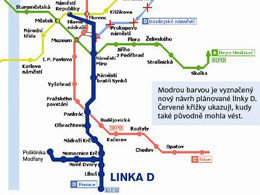
DPP will initiate geological surveys to begin the construction of the metro line D
 |
In the first phase, the line will be created between Pankrác, Nové Dvory, and will continue to the Písnice Depot, where driverless trains will operate. The costs are estimated at 57 billion crowns. In the future, a section from Pankrác to Náměstí Míru is planned. The investor for the construction will be DPP.
"On Monday (May 27), excavators will start moving in and the plots will begin to be fenced. The ceremonial start of the metro construction will be on June 20, and I will take a shovel myself. We are conducting the geological survey in order to avoid problems that occurred during the construction of the Blanka tunnel when ground subsidence happened in Stromovka," said Deputy Mayor Adam Scheinherr (Praha Sobě).
This Thursday, Prague councilors will discuss the construction of Metro Line D and will approve the financing of the construction. Afterwards, DPP and the city will conclude contracts with the suppliers of the geological survey.
"The Pankrác area is geologically very complex; there used to be a volcano there, and we need to be sure that everything will be alright, not only because the routes intersect," said the general director of DPP, Petr Witowski.
Service on Metro Line C will not be interrupted; trains will only pass through the station more slowly during the survey.
The survey will take place in several locations in Pankrác. The shafts, tunnels, and other underground spaces created during the survey will not be filled in, but will be used for the metro. The excavated shafts and tunnels are planned in locations where the track tunnels, transfer corridors will be located, or will serve for ventilation.
Of the total amount, according to the breakdown of survey costs available to ČTK, about 1.28 billion crowns will go towards the survey itself. Another 145 million will be spent on monitoring. The remaining funds will go, among other things, for documentation and part of them is reserved as a contingency.
The city leadership and DPP are still addressing the issue of the missing plots of land necessary for construction. Currently, they are negotiating with landowners in Krč, for example. An so-called initial agreement regarding the plots near Nádraží Krč has already been signed with them. The city is facing problems around the future stations Libuše, Písnice, and Depo Písnice, where more extensive land exchanges are likely to be required.
At the beginning of April, Prague councilors decided that Prague would commission proposals for artistic solutions for each station from Pankrác to Písnice. They will adjust the originally proposed appearance of some elements in the stations. A special committee will then select the winners from these. For the station Náměstí bratří Synků, which is part of the section from Pankrác to Náměstí Míru, the city decided to organize an architectural competition for its design.
The former city leadership intended to create a company with a private entity that would deal with the construction. The reason was primarily the challenging acquisition of land, as a private company can purchase it at market prices, which public administration cannot. However, the current councilors do not prepare the establishment of similar companies. Scheinherr previously told ČTK that he does not oppose the creation of companies, but their establishment must be advantageous for the city and DPP.
The city leadership also decided that the Institute of Planning and Development should prepare a metro development strategy, which will decide on any further expansions.
The English translation is powered by AI tool. Switch to Czech to view the original text source.
0 comments
add comment
Related articles
0
14.08.2020 | The land near the metro was sold online for a record half a billion
0
15.06.2020 | Prague will have a study on the development of Nové Dvory prepared
0
15.07.2019 | Prague will sign an agreement with landowners for Metro D in Krč
0
27.05.2019 | DPP signed a contract with construction companies for the survey for metro D
0
17.05.2019 | Prague will approve a geological survey, which will initiate the construction of metro line D
0
25.05.2018 | DPP and Penta will establish a company for the purchase of land for the construction of metro line D
0
08.02.2018 | The partner of DPP for the construction of metro line D is to be Penta, the commission has decided
0
27.12.2017 | The Prague next year awaits investments in metro line D and elections
0
24.10.2017 | Prague will buy a plot of land in Písnice necessary for the construction of metro line D
0
15.09.2014 | Metro Line D will cost 60 billion, construction will start in 2017
0
08.10.2013 | The Prague council approved the construction of metro line D for 25 billion










